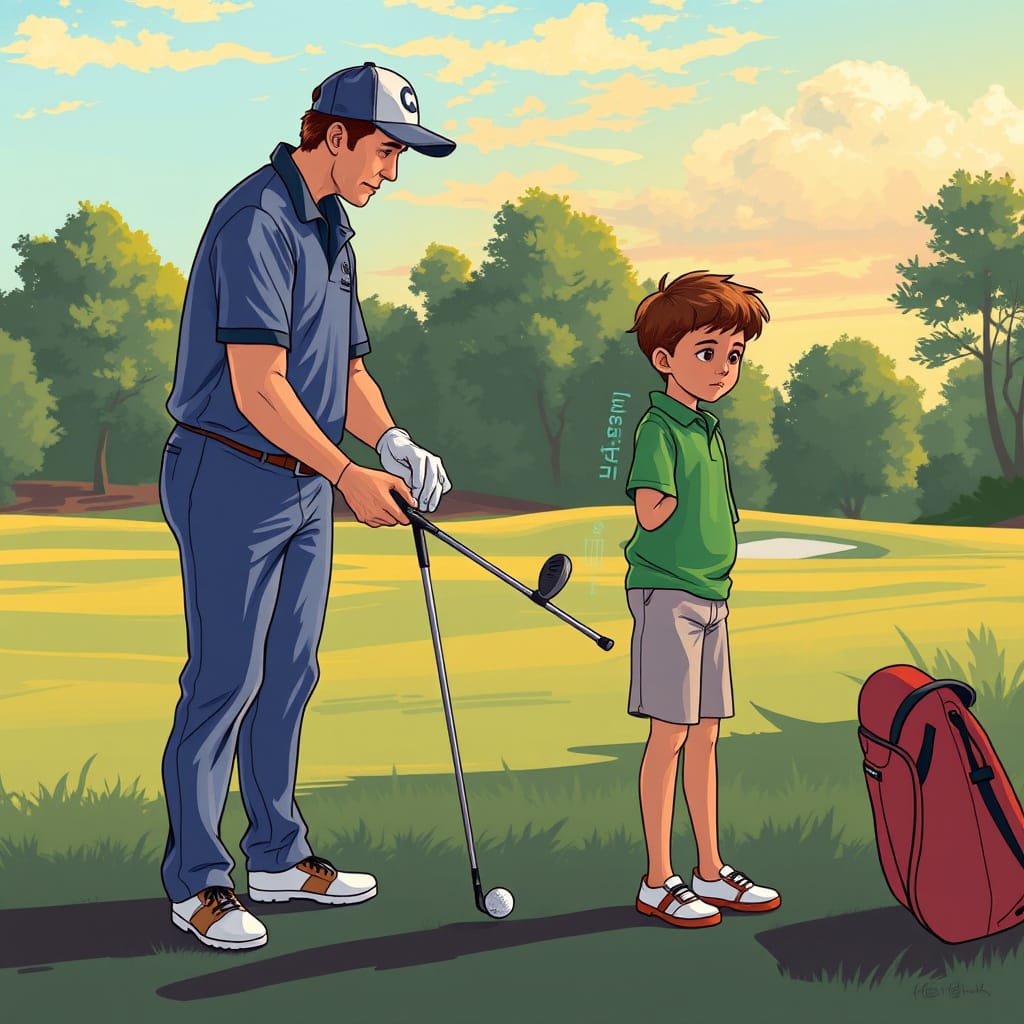8 Essential Golf Tips for Beginners: Learn the Basics & Improve Fast


Table of Contents
Key Takeaways
- The benefits golf brings are unlike any other. You’ll get great physical activity, social interaction and lifetime fun, so it’s truly a great hobby for people of all ages.
- Getting started doesn’t mean you need a lot of pricey equipment. Buy only what you need, look for cheaper alternatives, and buy used to maximize your dollar.
- Developing good grip, stance, and swing fundamentals from the beginning will create a strong base and allow you to advance more quickly.
- Plenty of dedicated practice time paired with professional instruction—whether in person or virtually—can shave years off the process and prevent beginners from developing bad habits.
- Selecting beginner-friendly courses, being aware of golf etiquette, and knowing basic rules will help you have a smooth, enjoyable start on the course.
- Being patient with yourself, staying positive and focusing on the little bit of progress you can see will help you enjoy the game for many years to come.
Golf tips for beginners are extremely helpful in getting new players started on the right foot, developing proper habits and clear skills from the ground up. First-time golfers in the United States often face fast greens, different grass types, and changing weather, from sunny days in Florida to cool mornings in the Midwest.
Grip properly, choose the appropriate club, and swing with a smooth tempo. These simple little tips will help you start saving strokes today! Understanding course rules and golf etiquette makes playing with others smooth and stress-free.
Every beginner struggles with where to put their feet or how far away they need to be from the ball. It’s the simple fixes that go furthest. The following pages will outline basic tips and walk through the step-by-step basics.
Plus, you’ll discover simple drills to help you improve on the range, putting green, and even at home.
Why Even Pick Up a Golf Club?
Golf is about so much more than just hitting a few shots. For some, it’s one of the best places to be outdoors with friends old and new. Not to mention, you’ll develop a lifelong skill! The moment you step onto a course, the clean air and wide-open spaces will soothe your soul and prepare you to tackle anything.
Even beginners get excited about the prospect of hitting balls on the range. Whether they arrive early and hit a few balls or take practice swings with plastic whiffle balls in an open field, it’s not so much the theory of it at first; it’s more about the timing and finding your groove.
More Than Just a Walk Spoiled
It’s no surprise that golf courses typically occupy the most beautiful areas, where lush greens and turquoise lagoons rest under expansive blue skies. It’s this competitive game of strategy that combines hand-eye coordination and physical agility.
Most newbies come with a starter set of clubs, maybe a driver, a few irons, a sand wedge and a putter. We make it easy and affordable, usually under $500. Playing with seasoned golfers can help you learn faster, whether you’re tackling a long hole or joking around after a tough shot.
An exceptional place to test yourself Golf is a wonderful sport in that every time you go play, it’s a completely new challenge.
The Unique Challenge and Reward
Golf requires intense concentration and an enormous amount of patience. It’s those tangible, early wins—first hitting a ball 100 yards, then 150, then 200—that create true confidence.
As a reminder, every round presents an opportunity to get better. Like the old golfing adage goes, play the course first, repair your swing afterwards. It’s the satisfaction of building your skills and watching yourself improve that brings you back.
A Game for Life, Seriously
Golf truly provides space for all—whether you are 5 or 95, a weekend duffer or a future pro. There’s never a shortage of new experiences, whether it’s an event in the community or playing on a new team.
Course etiquette, dress codes and course rules may differ, so don’t worry too much about dressing to impress. Take it one step at a time, have fun along the way and watch your passion for the game blossom.
Gearing Up Without Breaking the Bank
It might not seem like it, but golf doesn’t have to break the bank. Many newcomers get stuck thinking expensive gear means better results, but a smart approach keeps the game fun and affordable. Get started with a budget!

Agree on a reasonable golf budget before the season starts. Next, commit to a weekly or monthly spending cap. This allows you to pace your spending and stay organized, preventing any last-minute scrambling or stress.
Your First Set: Keep It Simple
A beginner new to the game needs just a driver, a few irons, a wedge and a putter. Remember, it’s the quality of the gear that counts, not the quantity. Brands and flashy features wait on, seek clubs which might be straightforward to hit and forgiving on mishits.
Don’t overload on options, it will just bog you down.
How Many Clubs Do Beginners Need?
For beginners this isn’t a huge deal, as most beginners perform just fine with 7–10 clubs. A driver, 2–3 irons or hybrid, a wedge and a putter cover most any shot. Fewer clubs equals less confusion and a better learning experience.
As you mature as a player, you can begin to acquire more specialty clubs.
Essential Extras: Balls, Tees, Shoes
Purchase balls designed for learning—soft feel, low spin, affordable. Plastic tees are less expensive and hold up longer. Shoes need to be comfortable, but they need to provide you traction.
Essential Extras include plenty of balls—more than you think!
Smart Places to Buy Gear (US Focus)
Your local golf shop can provide fit you to clubs and give you advice. Online retailers provide wider selection and discounts. Discount shops and golf shows carry last year’s models for cheaper.
Renting or borrowing clubs before making a purchase is a great way to save money.
Why Used Clubs Are Your Friend
Secondhand clubs save you more cash and allow you to test brands and models. Purchase gently used gear at local shops or online. You’ll find that older clubs can be less intimidating and more enjoyable to swing.
Plus, buying used helps reduce waste.

Think About Club Fitting Early
Proper fit increases comfort and performance, especially for new golfers. Consider a fitting session at a retail outlet to optimize the golf clubs to your swing. As your game progresses, your golf equipment should progress with you to get the best performance out of your clubs.
Learning the Ropes: Mastering Fundamentals
Learning the ropes is not only for those new to the field; even experienced players often revisit beginner golf tips to enhance their skills and achieve greater accuracy. With this in mind, we’ll start with the basics and outline some key fundamentals that all beginner golfers should learn.
1. Understand the Basic Goal Simply
At its most fundamental level, the game of golf centers around getting a ball from tee to green, with the goal of achieving a decent golf score in the least number of shots. Just like each hole on a public golf course has a designated par, understanding this allows you to set achievable targets while measuring your own progress. For new golfers, grasping these concepts is essential for a successful start in their golf career.
Begin by learning the course map and reviewing where hazards—such as bunkers or water—are located. For beginners, good beginner golf tips include paying attention to the design of the greens. This knowledge helps you set up your shots effectively, rather than just hitting from the hip and praying for a miracle. Start building the habit of keeping score each round, as it’s not just a contest against fellow golfers, but a chance to understand your own progress.
It doesn’t take a massive decrease in strokes over the long haul to know that your golf experience is improving, especially when you apply basic golf swing tips and practice swing techniques consistently.
2. Grip the Club Like You Mean It
One of the most underrated aspects of the game is how you grip the club. An even, tension-free grip will allow you to achieve maximum control with maximum power. For beginner golfers, it’s crucial to understand that too loose a grip can hinder control over the club, while a grip that is too tight can restrict your range of motion. Learning grip fundamentals is essential for a solid golf swing.
Start with basic grip types such as overlapping, interlocking, or baseball grip. As a new golfer, experiment with each grip a few times and pay attention to which one feels more natural during your swing. An improper grip can affect club alignment and lead to shot inconsistency, which is why practicing with the right clubs is key. An effective grip aligns the club with the fleshy portion of your fingers, avoiding palm involvement.
Avoid the urge to adjust your grip with your thumbs, and keep them pointed directly down the shaft. Make it a habit to be aware of your grip every three swings or so. Even experienced players fall into this trap, especially during moments of pressure, so incorporating these beginner golf tips can greatly enhance your golf experience.
3. Find Your Athletic Stance
Find your athletic stance. Your stance is the foundation for your entire swing. Start with your feet at least shoulder-width apart. This athletic stance provides you the control of a solid base without being rigid. Bend at hips, not waist and allow your knees to flex only to the point where you feel stable.
Allow your arms to drop in front of you, suspended down from your shoulders. You want to feel more prepared to move, not stuck in place. As you practice various types of shots—such as drives, chips or putts—adjust your stance. For longer, more powerful shots, you may need to be in a wider position.
Short chips—move your feet in a bit. As with any new pose or practice, focus on comfort and balance instead of trying to achieve a rigid, illustrative standard.
4. Learn a Simple Swing Motion First
Golf swings may seem simple through the television screen, but in practice it’s something that requires time and dedication to master. Learn a simple swing motion first—create a one-piece takeaway, arms and shoulders going back together. Don’t swing the club for power first. Focus on getting through the ball in a straight, smooth path.
Having a controlled follow-through allows you to finish the swing in control and with balance. Dividing the swing into movements—backswing, downswing, follow-through—allows you to identify what needs to be fixed. Focus on learning a consistent swing motion first, without a ball.
This develops muscle memory and allows you to work on technique rather than being result-oriented.
5. Start Small: Chipping and Putting
The short game is the area where beginners will see the most immediate improvement. Chipping and putting are all about touch, not power. On the practice green, make short putts and chips from various locations. Aim to get as close to the hole as possible.
Implement drills that require them to land the ball consistently on the same spot. For shorter putts, practice putting strokes that ensure the ball rolls straight. For chips, practice a soft, controlled motion that allows the ball to land and roll. Mixing these drills into your practice schedule will first develop your skill, then sharpen your confidence when it’s time to step onto the course.
6. Sidestep Common Beginner Pitfalls
Let’s be honest, a lot of new golfers are looking for immediate results. When too much speed or force is behind the swing, that’s when you start risking those mishits. Take your time and concentrate on getting the most out of each phase of your swing.
There’s no getting around it—sh*t happens, missed strokes, bad lies, lost balls. Rather than becoming annoyed, turn these into teachable opportunities. Golf is as much a game of etiquette as it is about respect for your fellow player. Never assume you know who’s at bat, and never lean over the plate.
Avoid rushing play or intimidating other players. Keep in mind that all golfers were once beginners too. Don’t measure your advancement by other people, particularly those who are well-versed in the game already.
7. Easy Drills You Can Do Anywhere
Getting better at your game doesn’t require a class. At home, take out a club and practice your grip and stance in front of a mirror. Pay attention to your posture and overall body position. Do slow-motion swings without a ball to work on form.
This allows you to work out any glitches in your motion. Balance drills—such as standing on one foot—improve stability, an important foundation for powerful swings. It’s these uncomplicated practices that add up to help us the most, especially in the long run.
8. Feel the Rhythm: Find Your Tempo
Golf is as much rhythm as it is mechanics. Experiment with various tempos. Many professional musicians practice with a metronome or use their foot to stay in time. The idea is to have a swing that’s fluid from beginning to end, without jarring motions or abrupt pauses.
Let the beat roll, particularly when moving from the backswing to the downswing. This produces cleaner, more controlled, repeatable shots.

Practice Smart, Not Just Hard
Practice makes perfect, especially for beginner golfers. For novices, when it comes to practice, the quality of practice is much more important than the quantity of practice. Work smart to allow you to achieve more with less time. Now that’s the real difference. Quality over quantity—every single time.
For instance, by practicing your starting line on a 40-foot putt using full attention, you can improve dramatically. This targeted practice goes a lot further than mindlessly pounding balls on repeat. Practice smart. Don’t get ahead of yourself and think you’re better than you are. Those small changes, along with regular tracking and reporting, go a long way toward a solid golf swing.
Establish an objective for every workshop. Perhaps today is the day that you focus on hitting more fairways, or maybe it’s simply getting a consistent strike with the right clubs. Measure your success. Track your shots, analyze what’s working, and identify how you’re losing strokes.
This not only holds you accountable but allows you to visualize tangible change. Don’t forget to vary your practice regimen. Introduce new drills, identify areas of development, and avoid stagnation on the field. Changing it up prevents you from becoming complacent and raises the level of your golf game.
Make Driving Range Visits Count
Plan ahead. Choose a couple of drills to focus on before heading to the range. Avoid the practice range rut. Don’t simply smack balls—incorporate targets, develop various clubs, and generate on-course strokes.
Go for a target at specific yardages. Add a little stress to your practice by playing “games” such as hitting five fairways in a row.
Group Lessons vs. One-on-One Coaching
Group lessons provide opportunities for mutual learning and camaraderie. Individualized coaching means the guidance is focused entirely on your needs. Whether your preference is technological or traditional—there’s something available across a wide price range.
It doesn’t really matter which method, as long as you keep your head in the game and are inquisitive.
Leverage Online Golf Instruction
Instructions through online videos, apps, and forums are readily available. Find and follow—subscribe to trusted instructors on YouTube. Treat online tips as a supplement, not a shortcut.
Online golf communities will help you find answers to your questions and inspire you to practice regularly.

Why a Coach Helps from Day One
A coach corrects errors quickly and provides you with the discipline. With a coach, you receive unbiased feedback, personalized drill work and the push to inspire you to go the extra mile.
This kind of support prevents bad habits before they develop.
Build a Basic Practice Habit
Learn to follow through on an idea. Set realistic expectations and begin with a manageable time commitment—such as 15 minutes per day—and gradually increase.
Take practice to the course as well as the range. Record your minutes, track your progress, and allow consistent practice over time to propel you to the next level.
Taking Your Game to the Green Grass
Making the transition from the practice range to the actual golf course is a huge leap for any novice. At the range, it’s much easier to pay attention to your swing, hone fundamentals, and adjust your grip or alignment. Yet as exciting as it is to step onto that green grass, there are some different experiences and a few new challenges that await.
Open your mind and adapt to the speed of play! Whatever the case, stay calm when things don’t go right. Selecting the optimal course, training diligently, and being attuned to the rhythm of the game put you in position to succeed. Here’s what you need to know to ensure your first rounds are smooth, enjoyable, and productive.
Find Welcoming Local Courses (US Types)
Publicly owned golf courses make up the majority of golf courses in the U.S., and they’re usually the most open to new golfers. Municipal courses, especially at the local and municipal level, can offer simpler layouts, more accessible pricing, and looser dress codes relative to private clubs. They’re some of the best spots to get started, as staff are usually patient and accustomed to helping new golfers.
Some courses take an extra measure by hosting “beginner days” or have reduced green fees for people who are just starting to learn the game. Par-3 courses offer a more welcoming environment. Each hole is less than par length, making it possible for newcomers to learn the fundamentals at their own pace without the pressure.
These courses allow you to work on SHOT game skills—putting and chipping being the most important, because they help develop confidence from the start. Look at online reviews to choose a place with a welcoming atmosphere. Golf subreddit discussion boards and recommendations from local Facebook groups can give you real-time advice on what courses are more welcoming to newcomers.
Pay close attention to reviews related to staff friendliness, course challenge level, and inclusiveness.
Book Your First Tee Time Easily
Most public golf courses are now using online booking systems, which provide convenient ways to view available slots, compare rates, and book a tee time ahead of your trip. To add a personal touch, or if you have further inquiries, it’s easiest to just call the pro shop. The staff there should be able to direct you when it’s less congested and recommend optimal times for beginner golfers.
Making a reservation in advance is a good idea, particularly on weekends or holidays when courses tend to get booked quickly. Early mornings or late afternoons on the weekdays are typically not as crowded, offering you more space to breathe and enjoy your golf experience.
Be sure to inquire about additional fees, equipment rentals, or any course rules beforehand. Having confirmation on all these details means no surprises and no guesswork upon arrival at the course.
Plan to arrive at least a half hour before your scheduled tee time! This allows you time to prepare your golf equipment, register, and stretch out. From the outset, being organized and on time demonstrates respect and helps to ensure an enjoyable day on the links.

Golf Etiquette: Don’t Be That Person
Remember, golf is not just about one’s skill set; it also involves understanding the fundamental rules of etiquette. For beginner golfers, having a solid grasp of these rules will enhance your overall golf experience. Ensure you keep pace with the group in front of you and remain aware of your position on the course to avoid disrupting fellow golfers.
If you lose track of time, speed up your pace or allow quicker groups to tee off ahead of you. Golf Etiquette Tip #2 – Silence is Golden When It’s Not Your Turn to Hit. Precision and patience. Stand still, mute your phone, and don’t be a pesky fly buzzing around the camera.
Leave the course better than you found it—replace your divots on the fairway and repair ball marks on the green. Simple things like this go a long way in maintaining the condition of the course for all to enjoy.
Understand Basic Scoring Lingo
Golf has its own language. Words such as “par” stand for the number of strokes you should take on a hole. You can expect to hear “birdie” for one under par and “bogey” for one over par throughout each round. Newbies can easily keep a score with basic, uncomplicated scorecards, something that most courses offer at no charge.
Understanding how to score each hole and then add up your round is an empowering experience. Handicaps are the other aspect of scoring, allowing golfers of varying abilities to play against each other equitably. No formal handicap required to begin!
While it can be very confusing, knowing what it means will allow you to have an appropriate target as you work to get better.
Essential Rules for Beginners
The rules of golf are pretty simple and straightforward. Don’t move the ball, don’t ground the club in a hazard, don’t cheat! Losing a ball or hitting out of bounds will lead to penalty strokes where you add to your score. Understanding these basic rules will save you hours of frustration!
Courses will usually have their own specific “local rules” posted outside the clubhouse or printed on the scorecard. This could include water hazards, out of bounds areas, or changes that are temporary due to maintenance. Spend a few minutes before teeing off to familiarize yourself with them.
If you don’t understand a rule, seek out a staff member or someone with more experience to clarify the point.
Dress the Part: Golf Attire Basics (US)
While most US public courses have pretty laid back dress codes, it’s always a wise idea to check beforehand. Collared shirts and khaki shorts or pants are a no-fail combination. Moisture-wicking, lightweight, breathable fabrics help you stay cool and dry, with added comfort on hot, humid summer days.
Golf-specific shoes fitted with soft spikes provide traction and balance, but most courses permit athletic shoes. If the course does have a strict dress code, it will be listed on the website or the pro shop staff will inform you.
Having the proper gear not only makes you more comfortable, it lets you become part of the show.
Keep Pace: Play Ready Golf
Ready golf is about being more aware and prepared, and playing your shot when safe to do so, rather than waiting to play until it’s your official turn. When it’s others’ turns to hit, use that time to plan out your next shot, select your club, and align your stance.
Don’t take unlimited practice swings—this is just slowing everyone down. Keeping track of your metrics—whether it be fairway hits, greens in regulation, or putts per round—provides you with quantifiable data to improve on in-between rounds.
Little actions, whether it be alignment sticks or getting into the shot routine, go a long way with repetition. Being prepared and having an efficient pace of play ensures everyone has a great day on the course. It makes sure you’re getting the most out of your time on the course!

The Mental Game: Patience is Key
Golf is one of the most popular mental sports. Research indicates that it’s 90% mental and 10% physical. For beginner golfers, the mental game of patience is the most important factor in your improvement. An untroubled headspace will go a long way in preparing you for the unhurried pace, the silence, and the extended learning curve.
There are valuable beginner golf tips to be learned on each go-around. Fighting this only takes the fun out of the game and stunts development. Developing the right mental approach starts with viewing each shot as progress. Even a putt you miss or a slice you hit off the tee teaches you something.
The greatest players of all time, such as Jack Nicklaus, employed visualization and mental preparation prior to each and every shot. This can be messy and it requires patience. So much of what we do in golf, a new swing for example, requires a minimum of 60 days forcing the change on a daily basis.
Allowing yourself to screw up—and learn from screwing up—relieves the pressure and fosters true proficiency. When you take the emphasis off the score and put it on having fun, it’s night and day. A thankful mindset towards every round keeps you focused and patient.
If a shot didn’t go as planned, forget it and focus 100% on the next one. Taking a deep breath before difficult shots will calm you down and make you believe in your ability to execute. Feel free to celebrate modest achievements, such as a decent drive or chip shot.
Share these wins with friends to increase feelings of optimism and hope. Patience is key; golf isn’t just an individual’s game. Like a tree-lined, open-air country club, U.S. public golf courses provide players with vitamin D, lush surroundings, and a relaxed pace.
The game is just as much about who you play with as it is how you play. Love them equally, and your patience—along with your mental game—will deepen.

Growing Your Game: What's Next?
That’s something every golfer, from the novice to the pro, is hoping to grow. The only sure way to ensure you continue making progress is to establish definitive goals and evaluate after each round. Incremental improvements, such as eliminating a stroke from your average score or finding more fairways off the tee, are what count.
The reality is that the bulk of progress comes from repeating the right thing multiple times. It’s through this kind of deliberate and consistent practice that real meaningful skill gets developed.
When Should You Upgrade Clubs?
Something just feels off with your clubs. If you can’t start hitting better shots, it might be time to start shopping for some new sticks! Many start with a basic set, but as skills improve, better clubs can help.
Others realize they’re being limited by their outdated driver or irons. Consult a coach or experienced friend prior to purchasing. Regardless of how new and advanced the technology in clubs is, it won’t help improve your game if it’s not right for your individual swing and needs.

How Fitness Impacts Your Swing
Golf is more than just a game of swing mechanics. Fitness makes a significant difference when it comes to swinging with both power and control. Basic stretches, light strength exercises, and balance training all contribute.
Concentrate on motions that replicate your swing. Maintaining your overall fitness level will not only keep you from getting injured, but it will help you maintain your energy levels throughout an entire round.
Find Your Golf Tribe: Leagues & Buddies
It’s hard to emphasize just how much more fun golf is with friends or as part of a local league. More than anything, playing alongside others holds you accountable, encourages you to work harder, and helps you foster a system of support.
Sharing your victories, defeats, and lessons learned with your golf tribe helps to create an atmosphere of learning and improvement. Countless others learn quicker and take different paths by hearing others’ stories and missteps.
Continuous Learning is Crucial
There’s always more for even the most seasoned golfers to learn. Experiment with classes, pick up a book, check out an online course or instructional video. Track your own statistics with a smartphone app or notebook.
Continue to question assumptions and experiment with incremental adjustments, such as grip modifications. Specific, intentional practice—even in smaller doses—is far superior to aimlessly banging balls with no purpose or thought.

Conclusion
We know that starting golf can be intimidating at first, but each shot is an opportunity to learn and get comfortable. A modest investment in a used set of clubs and a handful of lessons can make for an enjoyable experience. Local public courses should be ready and willing to shower new, young players with attention. Even a couple of hours at the driving range will make you noticeably improve! The psychological aspect matters as much as your swing—maintaining your composure after an errant shot makes the sport enjoyable over the long run. Rule #10 Don’t be in a hurry. You’ll learn something new each round. These small victories not only make you a better golfer, they cultivate your passion for the game. Have a question or looking for some more beginner tips? Flick us an email or browse our other how-to guides. So, let’s help you stay on the right track with your golf journey, one swing at a time.
Frequently Asked Questions
What is the best way for a beginner to learn golf fundamentals?
Teaching grip, stance, and posture as the basic fundamentals is crucial for beginner golfers. Ideally, getting golf lessons from a local pro on site will help new golfers get comfortable with the fundamentals at a driving range before taking the plunge on an actual course.
Do I need expensive clubs to get started in golf?
Most major sporting goods retailers and pro shops offer beginner golf equipment, including entry-level package sets at reasonable prices. Additionally, secondhand golf clubs are a great option for new golfers.
How often should beginners practice golf?
Try to get out to practice your golf swing two to three times a week. By focusing on quality over quantity, you’ll create positive habits while avoiding burnout in your golf game.
What should I wear when golfing for the first time?
Plan to wear a collared shirt, golf or khaki shorts/pants, and comfortable golf shoes. While most American public golf courses will expect these, do double check local dress codes ahead of play.
Is it important to play on a real golf course as a beginner?
Yes. Once you get the hang of the essentials, taking golf lessons and actually playing on a real golf course allows you to experience a round and understand course etiquette and proper shot selection.
How do I keep calm when my shots go wrong?
Deep breath, new beginning, and a new shot to consider. As a new golfer, remember that mistakes happen to all of us, so give yourself time and be patient with your golf swing progress.
What should I do after learning the basics of golf?
Sign up for a league for beginners, get out and practice a lot with your golf clubs — and take more advanced golf lessons. Just as with golf, the more you practice and study, the better you’ll become.
This article contains affiliate links. If you purchase through them, I may earn a small commission at no extra cost to you. See our Affiliate Disclosure.






